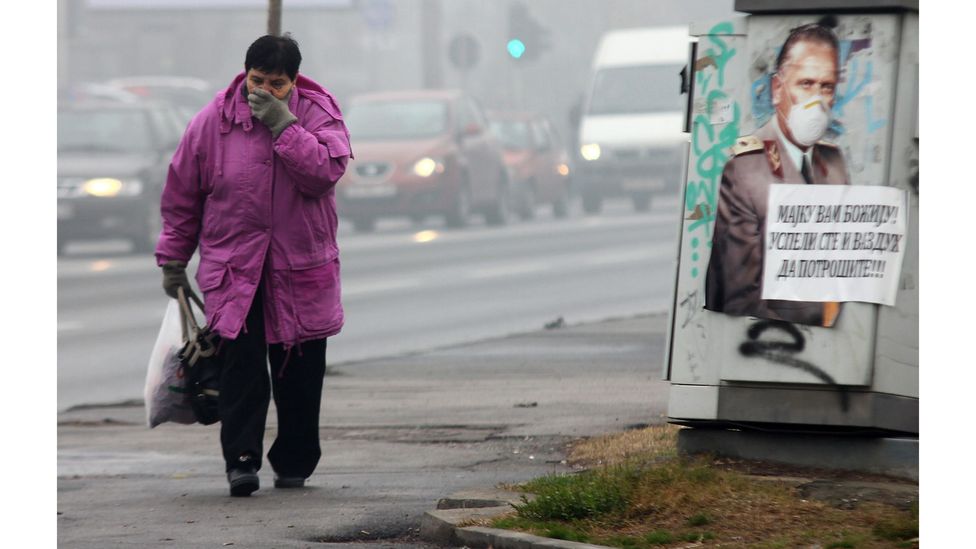For many people, a bout of Covid-19 gave a first taste (or rather a lack of it) of what it is like to lose their sense of smell. Known as “anosmia”, loss of smell can have a substantial effect on our overall wellbeing and quality of life. But while a sudden respiratory infection might lead to a temporary loss of this important sense, your sense of smell may well have been gradually eroding away for years due to something else – air pollution.
Exposure to PM2.5 – the collective name for small airborne pollution particles, largely from the combustion of fuels in vehicles, power stations and our homes – has previously been linked with “olfactory dysfunction”, but typically only in occupational or industrial settings. But new research is now starting to reveal the true scale – and the potential damage caused by – the pollution we breathe in every day. And their findings have relevance for us all.
On the underside of our brains, just above our nasal cavities, lies the olfactory bulb. This sensitive bit of tissue bristles with nerve endings and is essential for the enormously varied picture of the world we get from our sense of smell. It’s also our first line of defence against viruses and pollutants entering the brain. But, with repeated exposure, these defences slowly get worn down – or breached.
“Our data show there’s a 1.6 to 1.7-fold increased [risk of] developing anosmia with sustained particulate pollution,” says Murugappan Ramanathan Jr, a rhinologist at the Johns Hopkins School of Medicine, Baltimore. He has become one of the few experts in this field after he started to wonder if there was a link between the large numbers of patients he was seeing with anosmia and the environmental conditions where they lived.
The simple question he wanted to answer was this: were a disproportionate number of anosmia patients living in areas of higher PM2.5 pollution? Until recently, the little scientific research on this topic included one Mexican study in 2006, which used strong coffee and orange odours to show that residents of Mexico City – which often struggles with air pollution – tended to have a poorer sense of smell on average than people living in rural areas of the country.
With the help of colleagues – including environmental epidemiologist Zhenyu Zhang who created a map of historic air pollution data in the Baltimore area – Ramanathan set up a case-control study of data from 2,690 patients who had attended Johns Hopkins Hospital over a four year period. Around 20% had anosmia and most didn’t smoke – a habit that is known to affect the sense of smell.

Modern vehicles burning fossil fuels produce polluting nanoparticles of the size that can pass into the brain (Credit: Nake Batev/Anadolu Agency/Getty Images)
SENSORY OVERLOAD
From the microplastics sprayed on farmland to the noxious odours released by sewage plants and the noise harming marine life, pollutants are seeping into every aspect of our existence. Sensory Overload explores the impact of pollution on all our senses and the long-term harm it is inflicting on humans and the natural world. Read some of the other stories from the series here:
Sure enough, the levels of PM2.5 were found to be “significantly higher” in the neighbourhoods where patients with anosmia lived compared to healthy control participants. Even when adjusted for age, sex, race/ethnicity, body mass index, alcohol or tobacco use, the findings came up the same: “Even small increases in ambient PM2.5 exposure may be associated with anosmia”.
The finding has been echoed in other parts of the world in studies published this year. One recent study in Brescia, northern Italy, for example, found the noses of teenagers and young adults became less sensitive to smells the more nitrogen dioxide – another pollutant produced when fossil fuels are burned, in particular from vehicle engines – they were exposed to. Another year-long study in São Paulo, Brazil, also indicated that people living in areas with higher particulate pollution had an impaired sense of smell.
But exactly how is pollution wrecking our ability to smell?
According to Ramanathan there are two potential routes. One is that some of the pollution particles are passing through the olfactory bulb and getting directly into the brain, causing inflammation. “Olfactory nerves are in the brain but they have little holes at the base of skull where little fibres go into the nose, [looking] almost like little pieces of angel hair pasta,” says Ramanathan. “They are exposed.”
In 2016, a team of British researchers found tiny metal particles in human brain tissue that appeared to have passed through the olfactory bulb. Barbara Maher, a professor of environmental science at Lancaster University in the UK who led the study, said at the time that the particles were “strikingly similar” to those found in airborne pollution next to busy roads (domestic fireplaces and log stoves were another possible source). Maher’s study suggests that these nanoscale metal particles could, once in the brain, become toxic, contributing to oxidative brain damage that damages the neural pathways, although it still remains a theory.
The other potential mechanism, says Ramanathan, may not even require pollution particles getting into the brain. By hitting the olfactory bulb on an almost daily basis, they cause inflammation and damage to the nerves directly, slowly wearing them away. Think of it almost like coastal erosion, where sandy, salty waves eat away at the shoreline; substitute waves with pollution-filled air, and shoreline with our nasal nerves.
Modern combustion methods can create nanoparticles so fine that they are small enough to directly enter our bloodstream and brain tissue
Unsurprisingly then, anosmia disproportionately affects older people, whose noses have been assaulted by air pollution for longer. More surprisingly, none of the Johns Hopkins patients lived in areas with excessively high air pollution – many lived in leafy areas of Maryland, and none were from pollution hotspots. It suggests that even low levels of air pollution could cause problems over a long enough period.
A similar recent study has separately been carried out by the Aging Research Center at the Karolinska Institute, in Stockholm. Postdoctoral researcher Ingrid Ekström was puzzled by findings from the early 2000s that showed more than 5.8% of adults in Sweden had anosmia, and 19.1% had some form of olfactory dysfunction. Knowing that anosmia rates were higher in older people, Ekström and colleagues designed a study using 3,363 patients aged 60 and over. Using strongly scented “sniffing sticks” of 16 common household smells, participants received a score depending on the number they could correctly identify. As with the Baltimore study, the participants’ home addresses were mapped and analysed according to municipal air pollution readings. And as in Baltimore, there was a strong correlation between higher pollution levels and poorer smelling ability.
“They have been subjected to pollution throughout their lives,” says Ekström. “We don’t know exactly when their olfactory impairments started to decline.” But she is “confident” that long-term exposure to pollution was the cause, even at low levels.
In 2021, The World Health Organization (WHO) changed its health-based guidelines for a maximum annual average exposure to PM2.5, reducing it from 10 to 5 micrograms per cubic metre (µg/m3). Stockholm, Sweden’s capital, is one of the few major cities in the world that manages to stay below this level with an annual average of 4.2µg/m3. By comparison, Islamabad, in Pakistan, has an annual average PM2.5 levels of 41.1µg/m3 while it is 42.3µg/m3 in Bloemfontein, South Africa.
This arguably makes the Stockholm findings even more relevant – if even Stockholm residents are having their senses eroded by low levels of pollution, then how much worse will it be in regions with high levels?
It is also a reminder of how highly localised pollution can be, both outdoors and indoors. People’s cooking methods and heating choices may be exposing them to higher levels than their neighbours. (Listen to learn how effective air purifiers are.)
Meanwhile modern combustion methods from vehicle engines to the latest ‘eco’ wood stoves can create nanoparticles so fine that they barely register on PM2.5 readings, but are small enough to directly enter our bloodstream and brain tissue.
Air pollution is known to cause a quarter of all deaths from heart disease and stroke, and nearly half of all deaths from lung disease. By comparison, perhaps, our sense of smell seems low down the list of concerns. But both Ramanathan and Ekström warn that we underestimate the importance of smell at our peril.
Ekström’s research speciality is dementia. And anosmia may be an early warning sign.
“With dementia and especially with Alzheimer’s Disease, we assume that [the] disease progression is actually starting several decades before we can see the first symptoms,” says Ekström.
Anosmia is one of the first symptoms. By the time Alzheimer’s is diagnosed, “almost 90% of patients have anosmia”, says Ekström. The exact link remains unknown, but one theory is that “environmental toxins enter the central nervous system via the olfactory bulb and cause damage, triggering this cascade effect that may ultimately lead to neuro-degeneration”. The Maher Lancaster study, for example, found that metal nanoparticles were directly associated with the formation of ‘senile plaques’ – lesions on the brain and one of the neuropathological hallmarks of Alzheimer’s disease and dementia.
Despite such strong links, Ekström argues it is only recently that researchers have “opened their eyes to the olfactory sense” and its role in disease.

Losing our sense of smell may seem trivial next to other health effects of air pollution, but this misses the important role it plays in our lives (Credit: Md Manik/Getty Images)
Loss of smell has been linked to increased likelihood of depression and anxiety in various studies, and is known to play a role in obesity, weight loss, malnutrition and cases of food poisoning. The reasons are perhaps obvious – our noses play a key role in our experience of the world around us, affect our ability to taste food and help us avoid meals that have gone off.
A poor sense of smell may mean that sufferers are likely to seek out stronger tasting food, which is very often salty and fatty. By contrast, a total loss of smell can put people off food and lose enjoyment from it, ultimately becoming underweight – a particular problem amongst the elderly.
Ramanathan has seen many patients who “can’t taste food, can’t smell their wine, the things that gave them pleasure in life”. He recalls one patient who was a professional sommelier, for whom developing anosmia was both personally and professionally devastating.
Smell and taste are also linked to memory. “People don’t remember what that pastry looked like that they ate in France, but they remember what the shop smelled like”, says Ramanathan. Re-experiencing a particular smell can transport our memories straight back to that moment in pastry shop. This raises the question – albeit yet to be properly studied – whether the inverse could also true, and no longer being able to smell could impair our ability to create new memories in the same way.
Anosmia could also be an indicator of other, wider health issues. Numerous studies, typically of smokers – for whom smell impairment persists even 15 years after quitting – have shown that olfactory dysfunction is significantly associated with increased mortality among older adults. One particular study even hypothesised that anosmia could be used as a predicator for greater likelihood to die – from any cause – amongst older adults over a five-year-period. In a study of 3,005 US adults aged 57 to 85, those with anosmia were found to be four times more likely to die than their peers five years later. The researchers concluded that deteriorating sense of smell could be a “bellwether” for the accumulation of toxins from the environment or slowed regeneration of cells.
So, should we care that air pollution – to which we are all exposed – is impairing our sense of smell and causing anosmia? Clearly, the answer lies somewhere between “yes” and “hell yes”.
Ramanathan, for whom traffic pollution and waste incinerators top the local pollution concerns in Baltimore, says “air quality matters”. “I think we need tight regulations and control,” he says. Many people may not even realise the pollution they are exposed to, so they rely on politicians regulating it to protect the populations in the surrounding areas.
“This is one of many [pollution-related] conditions,” adds Ramanathan. “But this is kind of a special one, right? If you have COPD [chronic obstructive pulmonary disease] you could probably still enjoy your glass of wine. But not with this one.”
Ekström says tackling air pollution is not simple. World events can also cause unexpected shifts in behaviour – Ekström mentions anecdotally that winter wood burning has been on the rise in Stockholm as worried residents wean themselves off Russian gas. But even the every-day, low-level air pollution we are exposed to “should be taken more seriously”, she says. And what’s more, “olfactory impairment should definitely be taken more seriously”, too.
* Tim Smedley is author of Clearing The Air: the Beginning and the End of Air Pollution, published by Bloomsbury.
Source: Is air pollution causing us to lose our sense of smell? – BBC Future













